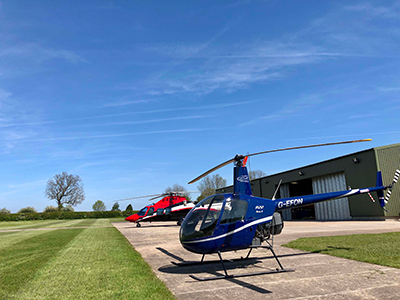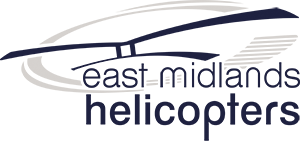
Learn to fly yourself for fun or a career!
At East Midlands Helicopters we train pilots to Private Pilot Licence (PPL(H)) and Commercial Pilot Licence (CPL(H)) level, usually using the popular Robinson R22 helicopter. However, we can also provide training on the Robinson R44 or Bell 206 JetRanger.
Please be aware we do not charge membership or circuit fees. We also do not charge for landing fees with the exception of cross country navigation land aways (approximately £30 in total).
Why not check out our trial lessons to get you started?
Contact us to find out more!Private Pilot Licence (PPL(H))
Requirements
- A minimum of 45 hours flying instruction, which must include at least 10 hours flying as ‘pilot-in-command’.
- A valid EASA Class 2 Medical Certificate.
- Passes in nine written examinations:
- Aviation Law
- Operational Procedures
- Principles of Flight
- Meteorology
- Navigation
- Radio Telephony
- Human Performance
- Flight Planning
- Aircraft General Knowledge
- Radio Telephony practical exam.
- Cross-country navigation exercise.
Frequently Asked Questions
No. You need no previous experience before starting your helicopter course, however if you do hold a current fixed wing licence the minimum flying hours requirement for the course is reduced from 45 hours to 39 hours.
None. As long as you are willing to learn and have a good degree of common sense we will teach you all you need to know.
No. Just as when you learn to drive you will take a test at the end of the course.
No. 45 hours is the minimum requirement, as laid down by the European Aviation Safety Agency (EASA), for a person to hold a Private Pilot Licence. It can sometimes take people a few more hours to meet the standard required by your examiner. It is not in the interest of safety for a flying school to guarantee a student a pass in a certain amount of hours, at East Midlands Helicopters we treat safety with paramount importance and therefore our students will only pass a test when their flying is up to a suitably high standard.
There is no set time over which you must do the course as long as you complete it, therefore we can tailor a course from a full time (3-4 days a week) up to spreading it over 2-4 years if you so desire. However, please bear in mind people tend to suffer from lack of continuity if they spread the course out over a long period of time.
Our courses are structured around what is required by EASA to grant the privilege of a PPL(H). The course must consist of the following elements:
Familiarisation with the Aircraft and Emergency Procedures.
Pre-flight and Post-flight Actions and Checks. Air Experience.
Effects of Controls.
Attitude and Power Changes.
Straight & Level Flight, Climbing, Descending and Turns.
Basic Autorotations.
Hovering, Hover Taxiing, Spot Turns. Hovering and Taxiing Emergencies.
Landing and Take Off.
Transitions
Circuits. Steep and Limited power Approaches. Circuit Emergencies.
First Solo.
Sideways and Backwards.
Spot Turns.
Hover OGE, Vortex Ring.
Engine Off Landings.
Advanced Autorotations.
Forced Landings.
Steep Turns.
Precision Transitions.
Quick Stops.
Navigation.
Advanced Take-Offs, Landings and Transitions.
Sloping Ground.
Limited Power Operations.
Confined Area Operations.
Instrument Flying.
The components of the course may not always be followed in order, and will depend on many factors. A full study guide is available on commencement of training.
Pre-flight and Post-flight Actions and Checks. Air Experience.
Effects of Controls.
Attitude and Power Changes.
Straight & Level Flight, Climbing, Descending and Turns.
Basic Autorotations.
Hovering, Hover Taxiing, Spot Turns. Hovering and Taxiing Emergencies.
Landing and Take Off.
Transitions
Circuits. Steep and Limited power Approaches. Circuit Emergencies.
First Solo.
Sideways and Backwards.
Spot Turns.
Hover OGE, Vortex Ring.
Engine Off Landings.
Advanced Autorotations.
Forced Landings.
Steep Turns.
Precision Transitions.
Quick Stops.
Navigation.
Advanced Take-Offs, Landings and Transitions.
Sloping Ground.
Limited Power Operations.
Confined Area Operations.
Instrument Flying.
The components of the course may not always be followed in order, and will depend on many factors. A full study guide is available on commencement of training.
Yes. 45 hours flight training is the minimum required by EASA. This must include 10 hours as "pilot-in-command", of which 5 hours must be solo cross-country flight. You must also carry out one cross-country flight of at least 100nm (185km).
The minimum age requirement for a holder of a PPL(H) is 17, however if someone younger than 17 wishes to start and learn this is no problem but he/she would not be able to fly solo or pass the skill test until their 17th birthday.
At East Midlands Helicopters we have "in house" examiners and can take you right through from scratch to passing the skill test to obtain the licence.
You may start the course without holding a medical but before you fly solo you must pass an EASA Class 2 medical which must be conducted by an EASA approved doctor. We have a list of the approved doctors and can steer you towards the nearest. The medical is not as stringent as many insurance check ups but pays close attention to heart, blood pressure, hearing, eyesight etc. Please note colour blindness does not necessarily preclude you from holding a medical. For more details visit the medical section on the CAA website. We advise that you have this medical prior to commencement of training.
No. The holder of a PRIVATE Pilot Licence is entitled to fly a helicopter for his/her own private use with family/friends etc. or on his/her own business trips. In order for you to work as a pilot and receive revenue for your services you must become a Commercial pilot or Instructor.
The licence is valid for life, however to keep the R22 Type Rating on your licence, you must pass a proficiency check every 12 months.
You must do a conversion onto each particular type you require to add to your licence.
No. You can self fly hire one of our aircraft for your own use when you have your licence.
You only pay for the hours you fly, if you hire a helicopter for the day you will only pay for the time it flies, subject to a possible minimum. When you are learning you will spend a considerable amount of time on the ground being briefed by your instructor, this time is not chargeable.
You can take a helicopter almost anywhere you wish and land it at any civil airfield subject to its terms and conditions but more importantly you can land in anybody's field or private site, e.g. hotel, restaurant, golf course etc, provided you have the owner's permission and you do not violate any air traffic control rules whilst doing so. Our experienced staff will be pleased to assist with site selection and the relevant permissions.
Yes. Air travel generally is statistically far safer than road travel. In the hands of a sensible and well trained pilot the helicopter is an excellent form of transport, which can be safely landed in the rare event of an engine failure. Many people think that if the engine fails in a helicopter the situation is dire, this is not the case. During your course your instructor will demonstrate and subsequently teach you how to land the helicopter safely without the engine running.
Helicopter flying is a skill that most people can achieve to a satisfactory level after sufficient practice. There will always be certain people who find controlling a helicopter a little too difficult but 99 % of people who start the course do complete it to a safe standard.
This information is contained on the Civil Aviation Authority website.
